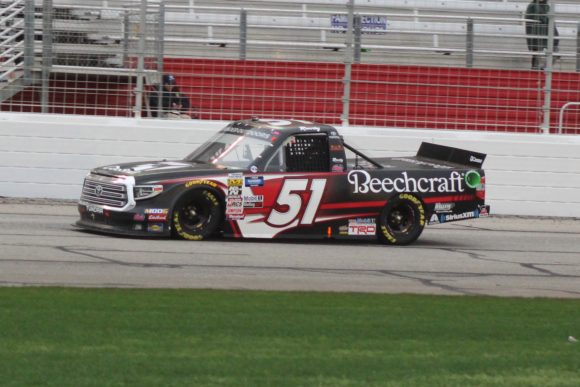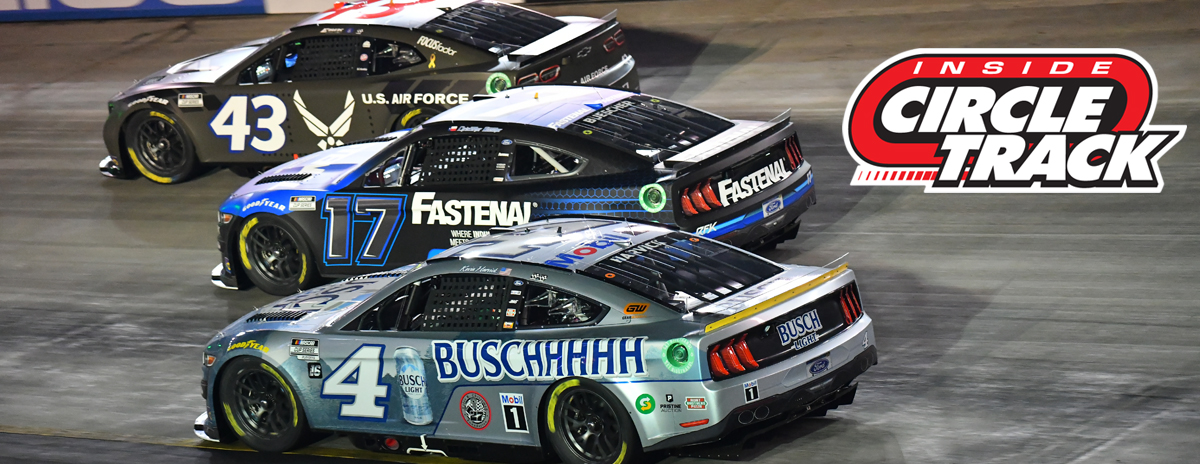
Greg Biffle won the SpeedyCash.com 400 driving for Kyle Busch Motorsports but that might not have been the biggest part of the story
On the surface, the SpeedyCash.com 400 NASCAR Gander Outdoors Truck Series race held on Friday night at the Texas Motor Speedway might seem like a somewhat historic event in the history of NASCAR because of the fact that driver Greg Biffle came out of retirement to score his first win in any of NASCAR’s top three divisions since 2013 and his first NGOTS victory since 2001. However, this race could actually go down in the history books for another reason as there may very well have been a new precedent set by the sanctioning body regarding the officiating of stage breaks.
As the truck race in Texas neared the conclusion of stage 1, which was to occur at lap 40, a caution flag waved for an incident involving Angela Ruch on lap 35. The cleanup for that wreck looked as if it might take longer than five laps which would cause the stage to end under yellow flag conditions. However, NASCAR officials chose to display the red flag, thus halting the race briefly, to allow for the track to be cleared. Ultimately this move brought about a mad dash to the green and white checkered flag used to symbolize the end of a stage.
The significance of this is that this appears to be the first time NASCAR has chosen to red flag a race solely for the purpose of ending a stage under green. There have been instances of red flags prior to the end of stages but those cases involved more extensive cleanups than this particular incident required. To show that this was not done to complete and extensive cleanup, the red flag period only lasted for just over one minute.
NASCAR reporter Jeff Gluck of TheAthletic.com made mention of this possibly precedent-setting moment on Twitter.
“Whoa, they red-flagged the race to try and get a green-flag finish to the stage? That may be the first time they’ve done that in any series since stages came around. Someone with a better memory correct me if I’m wrong.” – @Jeff_Gluck of The Athletic
Similarly, the 1998 Pontiac Excitement 400 held at the Richmond Raceway might well be most remembered for an incident that took place during the long-running feud between drivers Jeff Gordon and Rusty Wallace in which their two cars came together resulting in Gordon spinning and slamming into the turn two wall. But in reality, that race was historic for a more far reaching reason.
As that race neared its conclusion it was obvious that an intense four-way battle between Dale Jarrett, Ken Schrader, Terry Labonte and Rusty Wallace could potentially go right to the checkered flag. Even NASCAR officials seemed cognizant of the likelihood of a memorable finish and appeared not to want to interfere with the excitement. This became evident when Ward Burton spun on the backstretch with 10 laps remaining but the yellow flag was not displayed.
However, the car being driven by Kevin Lepage began dropping fluid on the track and officials were forced to call for a caution with just seven laps remaining. At that time, the pace car hurriedly got in front of Jarrett’s leading machine and slowed the field. Just before reaching the start/finish line for what would have been the signal for six laps to go, the pace car stopped and the field was shown the red flag so that clean up crews could clear the fluid from the track allowing for a race to the finish.
The race was being broadcast on ESPN and commentator Benny Parsons stated, “This is unprecedented. I don’t remember them ever doing this before.”
Ultimately, drivers were shown the green flag with four laps to go. Labonte, who was on fresher tires than the two front runners, passed by both Schrader and Jarrett to take the lead as the cars came to the white flag. The No. 5 Hendrick Motorsports Chevrolet won the race while Jarrett and his crew fumed at being the subject of the first instance of a race being red flagged for the purpose of staging a green flag finish.
Jarrett’s crew chief, Todd Parrott, commented after the race that, “They’ve got a tougher job up in that tower than what I’ve got. Making that decision wasn’t easy and, my guess, in the long run it was the right decision because it was a heck of a show and that’s what these people pay for.”
Parrott admitted that he was fighting back tears of frustration following the television interview.
Eventually all three of NASCAR’s top divisions would incorporate a standardized Green/White/Checkered rule that allows for “overtime” in events that have late race cautions. While the NGOTS had used a version of the G/W/C since 1995, the rule was broadened to include what is now the Monster Energy NASCAR Cup Series and the NASCAR Infinity Series in 2004 and has been tweaked multiple times since.
So, did we witness an entirely new precedent on Friday night in the SpeedyCash.com 400 at the Texas Motor Speedway?
Since points are awarded for stage placements, NASCAR may deem it necessary to halt future races just before stage breaks for the purpose of allowing drivers to race to the end of stages just as they opted to do for finishes back in 1998 during the Pontiac Excitement 400. And eventually, might we see G/W/C endings of stages just as we see at the end of the final run to the finish?
Richard Allen is a member of the National Motorsports Press Association
Respond to this piece on Twitter –> @RichardAllenIDR
or on Facebook –> InsideCircleTrack/Facebook
